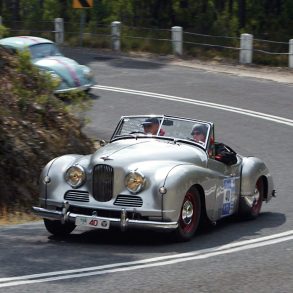After 16 years and more than eight million competitor kilometers, the Targa Tasmania tarmac rally has become an eagerly anticipated and addictive annual pleasure to around 275 entrants in production cars of all ages, who collect on Australia’s southernmost island state after Easter for a five-day road ritual.
For some, it’s the repeating thrill of mastering around 42 special stages of “die-for” drivers’ roads that wind through World Heritage wilderness scenery over five days; for many it’s the unique team experience against the road and the elements that bonds driver and co-driver into lifelong friendships; for others, it’s a tick at the top of their list of great motoring experiences.
Seven-time, Bathurst 1000, endurance race winner, Jim Richards, who has also won the Targa Tasmania a record eight times, describes its attraction to the enthusiast driver this way: “If you are interested in motorsport and want to have the best time you can in a car, you cannot do anything better. For five days we compete against the clock over magnificent roads on up to nine separate courses each day, with different and changing road conditions. You don’t get that anywhere else in the world. For me, it’s better than Bathurst!”
Named after the Targa Florio road race, which ran in Sicily from 1906 to 1973, the event remains unique in the world today as a tarmac event in which cars of all ages compete against the clock. While competition at the head of the field remains fierce, whether in the Classic Competition for cars built prior to 1991, or the more recent vehicles in the Modern Competition, the vast majority of Targa Tasmania participants enter the event for its unique driving experience, rather than seriously eyeing a podium place.
This year, entries in the Classic category surged to a nine-year high in the wake of major changes that created a scratch competition alongside the handicap classification that is based on vehicle era, with the pre-1991 cars enjoying similar status and trophies to their more modern brethren.
The story of the 2007 Targa Tasmania was not the tussle between the Porsche GT3 RS of Jim Richards and the Subaru WRX of Tony Sullens for “Modern” victory (which went to the WRX), but the epic duel amongst the Australian and American muscle cars for podium honors in the Classic division. And while two Porsche 911s eventually claimed the top two Classic spots, it was the 620 horsepower, orange, Holden Monaro of Victoria’s Steve Coad that chased them all the way to finish a close 3rd which captured the public’s interest. Behind Coad, a thundering pack of V-8 Holden Toranas, Ford Falcons, and Mustangs entertained spectators each day, with the new Glenorchy night stage under lights in Hobart drawing a big crowd of 15,000 to cheer on their heroes.
However, the star attraction of this year’s Classic Competition was unquestionably the appearance of actor Eric Bana (Black Hawk Down/Hulk/Troy/ Munich) in his personal and very potent NASCAR-like Falcon Hardtop. Giving the flying 650HP Ford its first competition shakedown, Bana demonstrated that it is possible to be both fast and famous. However, a slip off the road in treacherous weather conditions on Day 4 prematurely ended his event. No doubt he’ll be back.
But not everyone wants to race the clock and a growing category of Targa Tasmania is the Tour, in which participants travel the closed road stages at posted speed limits without the need to equip their cars with special roll-over protection or to obtain a full rally licence. It’s common to see couples in Porsches, Ferraris, Mustangs, and many classic sports cars touring first before making the commitment to compete in the following years.
The 2008 running of the Targa Tasmania is slated for April 15–20, 2008. For more information visit www.targa.org.au
By Michael Browning







